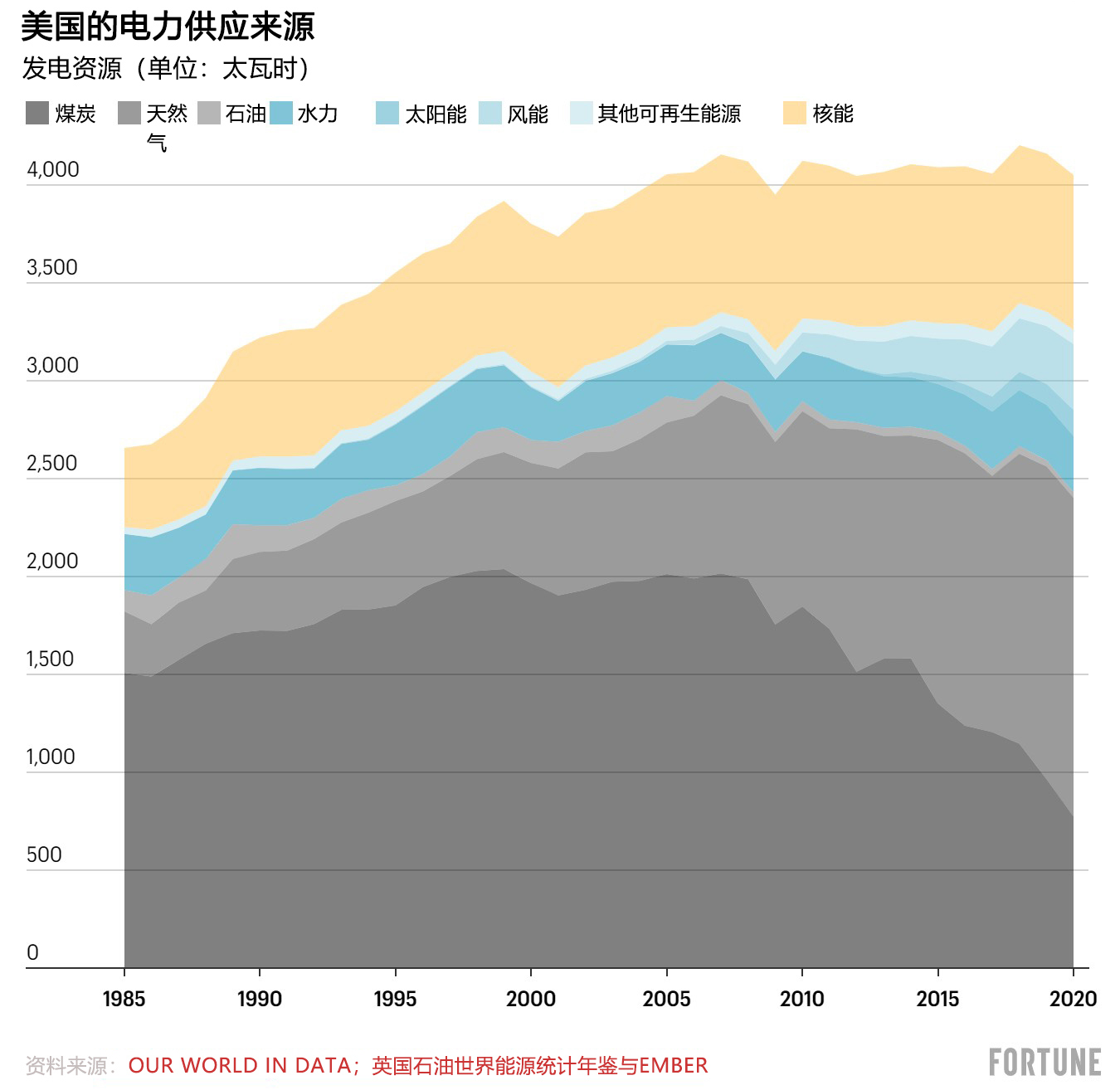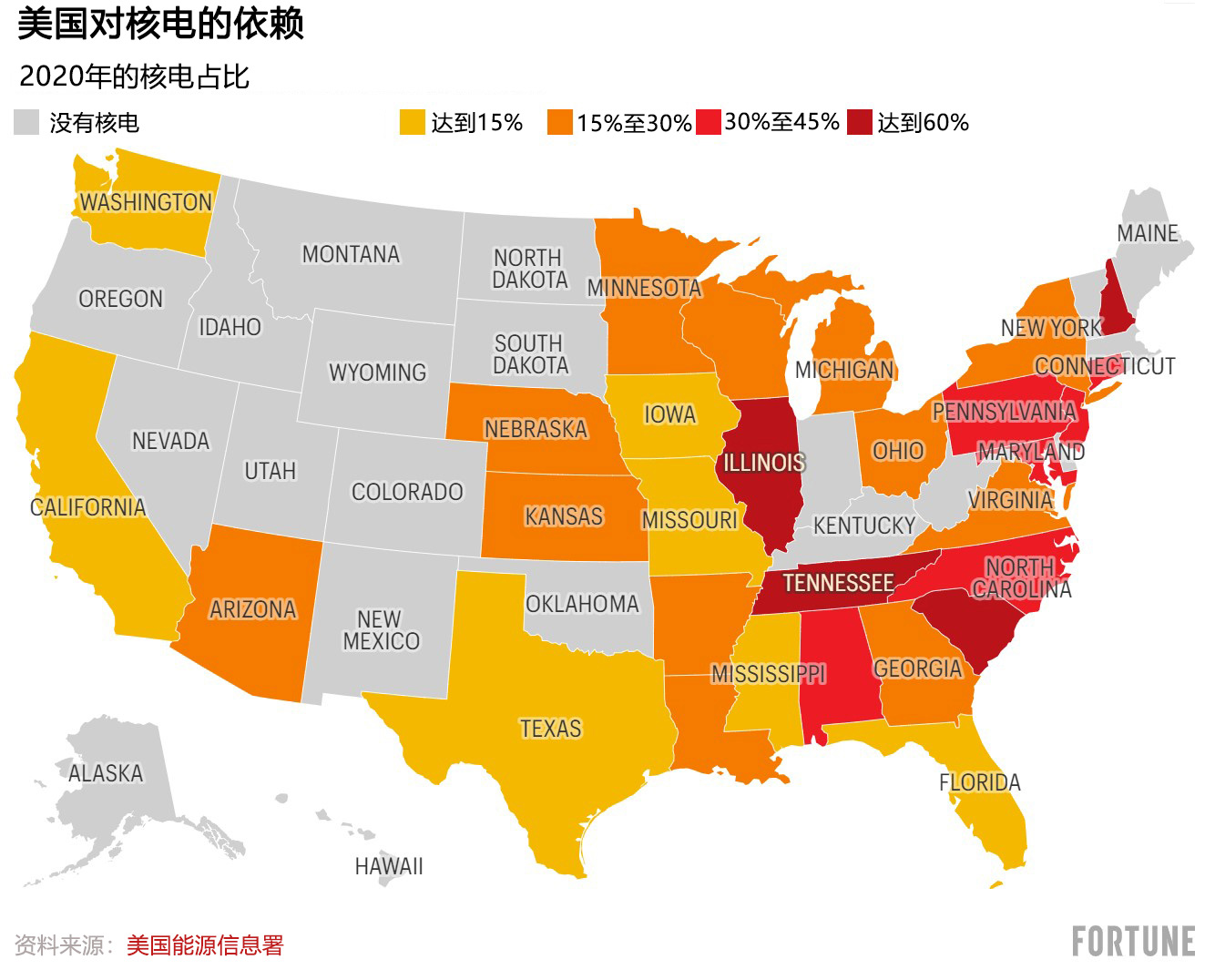美國(guó)的喬·拜登政府正在大力發(fā)展核電,再次將核電作為美國(guó)未來(lái)可持續(xù)能源戰(zhàn)略的關(guān)鍵,,這可能是美國(guó)在三十多年來(lái)首次增加核反應(yīng)堆建設(shè),。
白宮在其2022財(cái)年預(yù)算中申請(qǐng)18億美元用于發(fā)展核能,比2021年增加了50%,。美國(guó)能源部部長(zhǎng)詹妮弗·格蘭霍姆在最近召開(kāi)的聯(lián)合國(guó)氣候大會(huì)(UN Climate Conference)上對(duì)記者表示“我們非??春孟冗M(jìn)核反應(yīng)堆的前景”,并特別提到了新興的小型模塊化反應(yīng)堆技術(shù),。美國(guó)眾議院通過(guò)的“重建更美好未來(lái)”(Build Back Better)法案中包括補(bǔ)貼200億美元至250億美元用于維持舊反應(yīng)堆運(yùn)行,。拜登政府表示,美國(guó)94座核反應(yīng)堆對(duì)于其實(shí)現(xiàn)2050年前經(jīng)濟(jì)達(dá)到凈零碳排放的目標(biāo)“絕對(duì)是必不可少的”,。環(huán)保團(tuán)體綠色和平(Greenpeace)也不再以安全性問(wèn)題為由積極反對(duì)發(fā)展核電,。
之前美國(guó)曾經(jīng)有過(guò)幾次核能復(fù)興,但這次的情況不同?,F(xiàn)在氣候變化的威脅變得日益緊迫,;擴(kuò)大發(fā)展核能得到了美國(guó)兩黨的支持;技術(shù)進(jìn)步提高了核能的效率和安全性;美國(guó)政府為發(fā)展核電投入了數(shù)十億美元,。
美國(guó)此前曾經(jīng)有過(guò)類似的情況,。在美國(guó)前總統(tǒng)貝拉克·奧巴馬上臺(tái)之初,也曾經(jīng)出現(xiàn)過(guò)一次核能復(fù)興,,有30座新反應(yīng)堆申請(qǐng)建設(shè),。氣候變化的挑戰(zhàn)促使政策制定者重新看待核能作為零碳排放清潔能源的潛力。距離切爾諾貝利和三里島(Three Mile Island)核事故已經(jīng)過(guò)去了幾十年,,許多能源專家認(rèn)為核能未來(lái)前景光明,。但據(jù)《時(shí)代》(Time)周刊報(bào)道,美國(guó)只新建了兩座核反應(yīng)堆,,而且水力壓裂技術(shù)繁榮導(dǎo)致天然氣價(jià)格下降,,太陽(yáng)能和風(fēng)能等可再生能源得到了豐厚的補(bǔ)貼,面對(duì)這些能源的競(jìng)爭(zhēng),,發(fā)展核能的勢(shì)頭有所減弱,。日本福島的三座核反應(yīng)堆堆芯熔毀,導(dǎo)致15.4萬(wàn)人被緊急疏散,,此次事故讓世界各國(guó)紛紛放棄了核能發(fā)展計(jì)劃,,德國(guó)逐步關(guān)閉了最后六座核反應(yīng)堆,美國(guó)的公用事業(yè)公司也突然取消了雄心勃勃的新反應(yīng)堆建設(shè)計(jì)劃,。
新一代核能技術(shù)
目前,,美國(guó)20%的電力來(lái)自核能,50%的零碳排放電力是核電,。預(yù)計(jì)無(wú)論在美國(guó)國(guó)內(nèi)還是全世界,,核電的比例都會(huì)持續(xù)增長(zhǎng)。據(jù)國(guó)際原子能機(jī)構(gòu)(International Atomic Energy Agency)預(yù)測(cè),,全球核能發(fā)電容量到2050年將翻一番,。美國(guó)能源部(U.S. Department of Energy)非常看好核能的潛力,,并宣傳稱1千兆瓦核反應(yīng)堆的發(fā)電量,,相當(dāng)于300萬(wàn)塊太陽(yáng)能面板或400多臺(tái)風(fēng)力渦輪機(jī)的發(fā)電量。

新一代核能技術(shù)更安全,,對(duì)供需周期變化的響應(yīng)速度更快,。有多家雄心勃勃的初創(chuàng)公司正在率先采用這些技術(shù)。美國(guó)國(guó)防部(Defense Department)資助的X-energy計(jì)劃建設(shè)80兆瓦模塊化核反應(yīng)堆,,可以組裝成更大的反應(yīng)堆,。Oklo正在開(kāi)發(fā)一款浴缸大小的微型反應(yīng)堆,能夠?yàn)槭澜绺鞯氐钠h(yuǎn)農(nóng)村和社區(qū)供電,。
麻省理工學(xué)院(MIT)的核能工程專業(yè)教授雅各布·布翁焦?fàn)栔Z說(shuō):“現(xiàn)在發(fā)展核能的條件有利,。”他提到目前有越來(lái)越多的人對(duì)氣候變化感到擔(dān)憂,而核能技術(shù)的進(jìn)步提高了核能的安全性和效率,。
能源未來(lái)倡議(Energy Futures Initiative)的負(fù)責(zé)人約瑟夫·黑齊爾表示,,先進(jìn)核能是可能對(duì)實(shí)現(xiàn)脫碳產(chǎn)生顯著影響的突破性技術(shù)之一。黑齊爾曾經(jīng)在奧巴馬執(zhí)政時(shí)期擔(dān)任美國(guó)能源部部長(zhǎng)歐內(nèi)斯特·莫尼茲的顧問(wèn),。黑齊爾提到了過(guò)去15年核電領(lǐng)域的許多重要進(jìn)展:核電廠技術(shù)不再依賴輕水作為冷卻劑,,而是采用熔鹽和高溫氣體;濃縮鈾可持續(xù)時(shí)間更長(zhǎng),、效率更高,;設(shè)計(jì)和建設(shè)小型模塊化核反應(yīng)堆的能力增強(qiáng),能夠以更低的成本在工廠中建設(shè),,不需要龐大的建筑場(chǎng)地,。他指出,如果微型反應(yīng)堆在經(jīng)濟(jì)上可行,,并且可以得到成功部署,,就能夠在全世界打開(kāi)市場(chǎng),包括發(fā)展中國(guó)家,。五角大樓將在2027年年底之前,,在阿拉斯加建設(shè)和測(cè)試這樣一款新型反應(yīng)堆。
黑齊爾稱:“即使太陽(yáng)能和風(fēng)能等可再生能源技術(shù)被廣泛應(yīng)用,,間歇性問(wèn)題仍然存在,,并且需要儲(chǔ)能容量。因此,,核能這種既清潔又穩(wěn)定的電力來(lái)源依舊必不可少,?!?/p>

布翁焦?fàn)栔Z指出,,現(xiàn)有反應(yīng)堆逐漸老化,需要政府通過(guò)補(bǔ)貼保證這些反應(yīng)堆的安全運(yùn)行,,而微型反應(yīng)堆的建設(shè)周期很短,,商用反應(yīng)堆到2027年可以建成投產(chǎn)。但關(guān)鍵問(wèn)題是在取代化石燃料的過(guò)程中它們能夠產(chǎn)生多大的影響,,而且這些微型反應(yīng)堆真正發(fā)揮顯著作用可能要到本世紀(jì)中葉之后,。
如今,人們對(duì)于核電的安全性以及較高的運(yùn)行成本依舊存在擔(dān)憂,,可能威脅其作為一種氣候變化解決方案的可行性,。
雖然新一代核能技術(shù)將提高核電的可靠性,并幫助美國(guó)減少對(duì)化石燃料的依賴,,但專家質(zhì)疑在近期內(nèi),,核能對(duì)于實(shí)現(xiàn)零碳能源未來(lái)很難有所作為,無(wú)助于避免氣候變化最嚴(yán)重的影響。
美國(guó)核監(jiān)管委員會(huì)(Nuclear Regulatory Commission)的前主席艾莉森·M·麥克法蘭表示:“如果你認(rèn)為氣候變化問(wèn)題需要在未來(lái)15年或20年內(nèi)解決,,那么核能就無(wú)法發(fā)揮作用,。”她認(rèn)為近期的核能“熱”之所以再次引起關(guān)注,,是由于該行業(yè)“在公關(guān)和游說(shuō)方面的投入”,。

對(duì)于核電廠將對(duì)實(shí)現(xiàn)凈零能源未來(lái)作出重要貢獻(xiàn)這種說(shuō)法,麥克法蘭持懷疑態(tài)度,,因?yàn)楹穗姀S的建設(shè)周期很長(zhǎng),,而且“你聽(tīng)說(shuō)過(guò)的大多數(shù)新設(shè)計(jì)基本上都只是紙上談兵”,她還提到了發(fā)電廠運(yùn)營(yíng)的復(fù)雜性,。她表示,,由于美國(guó)數(shù)十年前就放寬了對(duì)電力市場(chǎng)的監(jiān)管,因此核能與天然氣和風(fēng)力發(fā)電競(jìng)爭(zhēng)并非易事,。麥克法蘭指出,,美國(guó)、英國(guó),、日本,、俄羅斯等世界各國(guó)為發(fā)展核能技術(shù)投入了數(shù)十億美元,但“沒(méi)有人能夠以合理的成本保證核電的經(jīng)濟(jì)性和可靠性,?!眹?guó)際原子能機(jī)構(gòu)的最新報(bào)告也指出,核能在全球發(fā)電容量中的占比可能從2020年的5%下降到2050年的2.4%至4.8%,,這意味著它取代化石燃料的潛力低于其他可再生能源,。
核能復(fù)興面臨的最后一項(xiàng)挑戰(zhàn)是民眾的態(tài)度。雖然美聯(lián)社(Associated Press)調(diào)查發(fā)現(xiàn),,三分之二美國(guó)人認(rèn)為核能未來(lái)將幫助取代化石燃料,,但大部分受訪者同時(shí)反對(duì)在國(guó)內(nèi)增加核電廠建設(shè)。
美國(guó)政府確實(shí)在幫助擴(kuò)大宣傳,,希望讓民眾相信核電的安全性和可靠性,。美國(guó)能源部在其官網(wǎng)上發(fā)表了一篇名為《關(guān)于核能是清潔和可持續(xù)能源的三個(gè)理由》(3 Reasons Why Nuclear Is Clean and Sustainable)的文章。其中解答了環(huán)保主義者最關(guān)注的兩個(gè)問(wèn)題:能源部稱與其他清潔能源相比,,核電占用的土地面積更小,,但發(fā)電量更高。關(guān)于長(zhǎng)期以來(lái)人們對(duì)于核廢料問(wèn)題的擔(dān)憂,,能源部稱“過(guò)去60年,,美國(guó)核能行業(yè)使用過(guò)的核燃料可以填滿深不到10碼、足球場(chǎng)大小的空間,?!钡茉床坎](méi)有提到核廢料超長(zhǎng)的半衰期,,活性最強(qiáng)的核廢料需要安全存儲(chǔ)100萬(wàn)年。
美國(guó)能源部表示,,其強(qiáng)烈支持發(fā)展先進(jìn)核反應(yīng)堆,,尤其是小型模塊化反應(yīng)堆和微型反應(yīng)堆,“以確保下一代核能技術(shù)可以滿足我們的能源需求,,并幫助實(shí)現(xiàn)減排目標(biāo),。”
加強(qiáng)公眾教育,,向人們宣傳核能技術(shù)是不斷演化的,,是核能復(fù)興持久的重要一環(huán)。
布翁焦?fàn)栔Z稱,,有些反對(duì)者的立場(chǎng)可能難以改變,。他認(rèn)為有一些對(duì)于核能安全性的擔(dān)憂早已過(guò)時(shí)?!熬拖袷怯腥苏f(shuō):‘我不想乘坐夢(mèng)想客機(jī),,因?yàn)槲矣浀门d登堡號(hào)飛艇曾經(jīng)發(fā)生過(guò)事故?!四芗夹g(shù)一直在快速演化,,現(xiàn)在的技術(shù)與早期技術(shù)相比就像蘋果與橘子的差別?!保ㄘ?cái)富中文網(wǎng))
翻譯:劉進(jìn)龍
審校:汪皓
美國(guó)的喬·拜登政府正在大力發(fā)展核電,,再次將核電作為美國(guó)未來(lái)可持續(xù)能源戰(zhàn)略的關(guān)鍵,這可能是美國(guó)在三十多年來(lái)首次增加核反應(yīng)堆建設(shè),。
白宮在其2022財(cái)年預(yù)算中申請(qǐng)18億美元用于發(fā)展核能,,比2021年增加了50%。美國(guó)能源部部長(zhǎng)詹妮弗·格蘭霍姆在最近召開(kāi)的聯(lián)合國(guó)氣候大會(huì)(UN Climate Conference)上對(duì)記者表示“我們非??春孟冗M(jìn)核反應(yīng)堆的前景”,,并特別提到了新興的小型模塊化反應(yīng)堆技術(shù)。美國(guó)眾議院通過(guò)的“重建更美好未來(lái)”(Build Back Better)法案中包括補(bǔ)貼200億美元至250億美元用于維持舊反應(yīng)堆運(yùn)行,。拜登政府表示,,美國(guó)94座核反應(yīng)堆對(duì)于其實(shí)現(xiàn)2050年前經(jīng)濟(jì)達(dá)到凈零碳排放的目標(biāo)“絕對(duì)是必不可少的”,。環(huán)保團(tuán)體綠色和平(Greenpeace)也不再以安全性問(wèn)題為由積極反對(duì)發(fā)展核電,。
之前美國(guó)曾經(jīng)有過(guò)幾次核能復(fù)興,但這次的情況不同?,F(xiàn)在氣候變化的威脅變得日益緊迫,;擴(kuò)大發(fā)展核能得到了美國(guó)兩黨的支持;技術(shù)進(jìn)步提高了核能的效率和安全性,;美國(guó)政府為發(fā)展核電投入了數(shù)十億美元,。
美國(guó)此前曾經(jīng)有過(guò)類似的情況,。在美國(guó)前總統(tǒng)貝拉克·奧巴馬上臺(tái)之初,也曾經(jīng)出現(xiàn)過(guò)一次核能復(fù)興,,有30座新反應(yīng)堆申請(qǐng)建設(shè),。氣候變化的挑戰(zhàn)促使政策制定者重新看待核能作為零碳排放清潔能源的潛力。距離切爾諾貝利和三里島(Three Mile Island)核事故已經(jīng)過(guò)去了幾十年,,許多能源專家認(rèn)為核能未來(lái)前景光明,。但據(jù)《時(shí)代》(Time)周刊報(bào)道,美國(guó)只新建了兩座核反應(yīng)堆,,而且水力壓裂技術(shù)繁榮導(dǎo)致天然氣價(jià)格下降,,太陽(yáng)能和風(fēng)能等可再生能源得到了豐厚的補(bǔ)貼,面對(duì)這些能源的競(jìng)爭(zhēng),,發(fā)展核能的勢(shì)頭有所減弱,。日本福島的三座核反應(yīng)堆堆芯熔毀,導(dǎo)致15.4萬(wàn)人被緊急疏散,,此次事故讓世界各國(guó)紛紛放棄了核能發(fā)展計(jì)劃,,德國(guó)逐步關(guān)閉了最后六座核反應(yīng)堆,美國(guó)的公用事業(yè)公司也突然取消了雄心勃勃的新反應(yīng)堆建設(shè)計(jì)劃,。
新一代核能技術(shù)
目前,,美國(guó)20%的電力來(lái)自核能,50%的零碳排放電力是核電,。預(yù)計(jì)無(wú)論在美國(guó)國(guó)內(nèi)還是全世界,,核電的比例都會(huì)持續(xù)增長(zhǎng)。據(jù)國(guó)際原子能機(jī)構(gòu)(International Atomic Energy Agency)預(yù)測(cè),,全球核能發(fā)電容量到2050年將翻一番,。美國(guó)能源部(U.S. Department of Energy)非常看好核能的潛力,,并宣傳稱1千兆瓦核反應(yīng)堆的發(fā)電量,,相當(dāng)于300萬(wàn)塊太陽(yáng)能面板或400多臺(tái)風(fēng)力渦輪機(jī)的發(fā)電量。
新一代核能技術(shù)更安全,,對(duì)供需周期變化的響應(yīng)速度更快,。有多家雄心勃勃的初創(chuàng)公司正在率先采用這些技術(shù)。美國(guó)國(guó)防部(Defense Department)資助的X-energy計(jì)劃建設(shè)80兆瓦模塊化核反應(yīng)堆,,可以組裝成更大的反應(yīng)堆,。Oklo正在開(kāi)發(fā)一款浴缸大小的微型反應(yīng)堆,能夠?yàn)槭澜绺鞯氐钠h(yuǎn)農(nóng)村和社區(qū)供電,。
麻省理工學(xué)院(MIT)的核能工程專業(yè)教授雅各布·布翁焦?fàn)栔Z說(shuō):“現(xiàn)在發(fā)展核能的條件有利,。”他提到目前有越來(lái)越多的人對(duì)氣候變化感到擔(dān)憂,,而核能技術(shù)的進(jìn)步提高了核能的安全性和效率,。
能源未來(lái)倡議(Energy Futures Initiative)的負(fù)責(zé)人約瑟夫·黑齊爾表示,,先進(jìn)核能是可能對(duì)實(shí)現(xiàn)脫碳產(chǎn)生顯著影響的突破性技術(shù)之一。黑齊爾曾經(jīng)在奧巴馬執(zhí)政時(shí)期擔(dān)任美國(guó)能源部部長(zhǎng)歐內(nèi)斯特·莫尼茲的顧問(wèn),。黑齊爾提到了過(guò)去15年核電領(lǐng)域的許多重要進(jìn)展:核電廠技術(shù)不再依賴輕水作為冷卻劑,,而是采用熔鹽和高溫氣體;濃縮鈾可持續(xù)時(shí)間更長(zhǎng),、效率更高,;設(shè)計(jì)和建設(shè)小型模塊化核反應(yīng)堆的能力增強(qiáng),能夠以更低的成本在工廠中建設(shè),,不需要龐大的建筑場(chǎng)地,。他指出,如果微型反應(yīng)堆在經(jīng)濟(jì)上可行,,并且可以得到成功部署,,就能夠在全世界打開(kāi)市場(chǎng),包括發(fā)展中國(guó)家,。五角大樓將在2027年年底之前,,在阿拉斯加建設(shè)和測(cè)試這樣一款新型反應(yīng)堆。
黑齊爾稱:“即使太陽(yáng)能和風(fēng)能等可再生能源技術(shù)被廣泛應(yīng)用,,間歇性問(wèn)題仍然存在,,并且需要儲(chǔ)能容量。因此,,核能這種既清潔又穩(wěn)定的電力來(lái)源依舊必不可少,。”
布翁焦?fàn)栔Z指出,,現(xiàn)有反應(yīng)堆逐漸老化,,需要政府通過(guò)補(bǔ)貼保證這些反應(yīng)堆的安全運(yùn)行,而微型反應(yīng)堆的建設(shè)周期很短,,商用反應(yīng)堆到2027年可以建成投產(chǎn),。但關(guān)鍵問(wèn)題是在取代化石燃料的過(guò)程中它們能夠產(chǎn)生多大的影響,而且這些微型反應(yīng)堆真正發(fā)揮顯著作用可能要到本世紀(jì)中葉之后,。
如今,,人們對(duì)于核電的安全性以及較高的運(yùn)行成本依舊存在擔(dān)憂,可能威脅其作為一種氣候變化解決方案的可行性,。
雖然新一代核能技術(shù)將提高核電的可靠性,,并幫助美國(guó)減少對(duì)化石燃料的依賴,但專家質(zhì)疑在近期內(nèi),,核能對(duì)于實(shí)現(xiàn)零碳能源未來(lái)很難有所作為,,無(wú)助于避免氣候變化最嚴(yán)重的影響,。
美國(guó)核監(jiān)管委員會(huì)(Nuclear Regulatory Commission)的前主席艾莉森·M·麥克法蘭表示:“如果你認(rèn)為氣候變化問(wèn)題需要在未來(lái)15年或20年內(nèi)解決,,那么核能就無(wú)法發(fā)揮作用,。”她認(rèn)為近期的核能“熱”之所以再次引起關(guān)注,,是由于該行業(yè)“在公關(guān)和游說(shuō)方面的投入”,。
對(duì)于核電廠將對(duì)實(shí)現(xiàn)凈零能源未來(lái)作出重要貢獻(xiàn)這種說(shuō)法,麥克法蘭持懷疑態(tài)度,,因?yàn)楹穗姀S的建設(shè)周期很長(zhǎng),,而且“你聽(tīng)說(shuō)過(guò)的大多數(shù)新設(shè)計(jì)基本上都只是紙上談兵”,她還提到了發(fā)電廠運(yùn)營(yíng)的復(fù)雜性,。她表示,,由于美國(guó)數(shù)十年前就放寬了對(duì)電力市場(chǎng)的監(jiān)管,因此核能與天然氣和風(fēng)力發(fā)電競(jìng)爭(zhēng)并非易事,。麥克法蘭指出,,美國(guó)、英國(guó),、日本,、俄羅斯等世界各國(guó)為發(fā)展核能技術(shù)投入了數(shù)十億美元,但“沒(méi)有人能夠以合理的成本保證核電的經(jīng)濟(jì)性和可靠性,?!眹?guó)際原子能機(jī)構(gòu)的最新報(bào)告也指出,核能在全球發(fā)電容量中的占比可能從2020年的5%下降到2050年的2.4%至4.8%,,這意味著它取代化石燃料的潛力低于其他可再生能源,。
核能復(fù)興面臨的最后一項(xiàng)挑戰(zhàn)是民眾的態(tài)度。雖然美聯(lián)社(Associated Press)調(diào)查發(fā)現(xiàn),,三分之二美國(guó)人認(rèn)為核能未來(lái)將幫助取代化石燃料,,但大部分受訪者同時(shí)反對(duì)在國(guó)內(nèi)增加核電廠建設(shè)。
美國(guó)政府確實(shí)在幫助擴(kuò)大宣傳,,希望讓民眾相信核電的安全性和可靠性,。美國(guó)能源部在其官網(wǎng)上發(fā)表了一篇名為《關(guān)于核能是清潔和可持續(xù)能源的三個(gè)理由》(3 Reasons Why Nuclear Is Clean and Sustainable)的文章。其中解答了環(huán)保主義者最關(guān)注的兩個(gè)問(wèn)題:能源部稱與其他清潔能源相比,,核電占用的土地面積更小,,但發(fā)電量更高。關(guān)于長(zhǎng)期以來(lái)人們對(duì)于核廢料問(wèn)題的擔(dān)憂,,能源部稱“過(guò)去60年,,美國(guó)核能行業(yè)使用過(guò)的核燃料可以填滿深不到10碼、足球場(chǎng)大小的空間,?!钡茉床坎](méi)有提到核廢料超長(zhǎng)的半衰期,活性最強(qiáng)的核廢料需要安全存儲(chǔ)100萬(wàn)年,。
美國(guó)能源部表示,,其強(qiáng)烈支持發(fā)展先進(jìn)核反應(yīng)堆,,尤其是小型模塊化反應(yīng)堆和微型反應(yīng)堆,“以確保下一代核能技術(shù)可以滿足我們的能源需求,,并幫助實(shí)現(xiàn)減排目標(biāo),。”
加強(qiáng)公眾教育,,向人們宣傳核能技術(shù)是不斷演化的,,是核能復(fù)興持久的重要一環(huán)。
布翁焦?fàn)栔Z稱,,有些反對(duì)者的立場(chǎng)可能難以改變,。他認(rèn)為有一些對(duì)于核能安全性的擔(dān)憂早已過(guò)時(shí)?!熬拖袷怯腥苏f(shuō):‘我不想乘坐夢(mèng)想客機(jī),,因?yàn)槲矣浀门d登堡號(hào)飛艇曾經(jīng)發(fā)生過(guò)事故?!四芗夹g(shù)一直在快速演化,,現(xiàn)在的技術(shù)與早期技術(shù)相比就像蘋果與橘子的差別?!保ㄘ?cái)富中文網(wǎng))
翻譯:劉進(jìn)龍
審校:汪皓
The Joe Biden administration is making a big push for nuclear power once again to be a key part of America’s sustainable energy future, which could lead to the first expansion of reactor construction in more than three decades.
The White House requested $1.8 billion for nuclear energy in its fiscal 2022 budget, a 50% increase from last year's levels, with Energy Secretary Jennifer Granholm telling reporters at the recent UN Climate Conference that "we are very bullish on these advanced nuclear reactors" and pointing to the emerging technology of small, modular reactors. The House-passed version of the Build Back Better bill also includes between $20 billion and $25 billion in subsidies to keep older reactors running. And the Biden administration says that the country's 94 nuclear reactors will be "absolutely essential" for the U.S. to achieve its goal of a net-zero carbon economy by 2050. Even the environmental group Greenpeace is no longer actively campaigning against nuclear power over its safety issues.
While there have been previous nuclear revivals, this time is different. The looming threat of climate change is more pressing than ever; there is bipartisan support for expanding our use of nuclear energy; advances in technology have made nuclear more efficient and safer than ever; and the government has committed billions in funding to nuclear power.
We've been here before. At the start of the Barack Obama administration, there was a nuclear renaissance, with applications for 30 new reactors in the U.S. The challenge of climate change was causing policymakers to take a fresh look at nuclear's potential as a zero-emission clean-energy source. It had been several decades since the Chernobyl and Three Mile Island disasters, and many energy experts were convinced that the future looked bright. But in the end, only two new reactors were built, according to Time magazine, and the momentum withered because of competition from the cheap natural gas of the fracking boom and well-subsidized renewables like solar and wind. And the meltdown of three reactors at Fukushima in Japan, leading to the evacuation of 154,000 people, scuttled plans around the globe, with Germany phasing out its last six reactors, and utilities in the U.S. abruptly dropping their ambitious plans for new ones.
A new generation of nuclear tech
Currently, nuclear supplies 20% of electricity in the U.S. and 50% of its carbon-free electricity. And those numbers are expected to grow at home and around the world. Global nuclear generating capacity is expected to almost double by 2050, according to the International Atomic Energy Agency (IAEA). Nuclear’s potential has been eagerly embraced by the U.S. Department of Energy, which touts the fact that it would take 3 million solar panels or more than 400 wind turbines to provide the same power as a one-gigawatt reactor.
A new generation of nuclear technology that is safer and more responsive to the cycles of supply and demand is being spearheaded by ambitious startups. X-energy, with funding from the Defense Department, is planning 80-megawatt modular reactors that can be assembled into larger operations, and Oklo is developing a micro-reactor the size of a hot tub that could power remote villages and communities around the world.
"A lot of stars are aligned right now," says MIT nuclear engineering professor Jacopo Buongiorno, pointing to increased concerns about climate change and the advancements in nuclear technology that have made it safer and more efficient.
Advanced nuclear is one of the breakthrough technologies that could have a significant impact on decarbonization, says Joseph Hezir, principal at the Energy Futures Initiative and former adviser to Obama-era Energy Secretary Ernest Moniz. Hezir points to several major developments in the past decade and a half: nuclear plant technology that doesn't rely on light water but molten salt and high-temperature gas for coolant; enriched uranium that is longer-lasting and more efficient; and the increased ability to design and build small modular reactors than can be constructed more inexpensively in factories rather than at a huge construction site. He notes that micro-reactors, if they can be economical and successfully deployed, could open up a lot of markets around the world, including developing countries. One of these newer reactors will be built and tested in Alaska by the Pentagon by the end of 2027.
"Even with deployment of renewable technologies like solar and wind, there is still the issue of intermittency and the need for storage capacity," says Hezir. "There is still a need for clean, firm power like nuclear."
While the existing reactors are aging and require government subsidies to keep them running safely, micro-reactors can be built very quickly, with a commercial unit up and running by 2027, says Buongiorno. But the key question is how much of an impact they can have on replacing fossil fuels, and it’s unlikely they will play a significant role before the middle of the century.
Nuclear power's safety reputation and costly operation remain ongoing concerns that threaten its viability as a climate change solution.
While the new generation of technology promises to make nuclear power more reliable and will help reduce America's reliance on fossil fuels, experts are doubtful that it will be able to significantly contribute to a zero-carbon energy future in the near future, in time to avoid the worst impacts of climate change.
"If you think climate change needs to be addressed in the next 15, 20 years, nuclear is not going to do that," says former Nuclear Regulatory Commission Chair Allison M. Macfarlane, who considers a lot of the renewed interest in the technology “hype” that is promoted by the industry “spending money on PR and lobbying.”
She doubts that nuclear power will make a significant contribution to helping achieve a zero-carbon energy future because it takes an extremely long time to build plants and “most of these new designs you're hearing about are basically pieces of paper,” noting the complexity of the operations. She also says that it won't be easy for nuclear to compete with natural gas and wind, due to the deregulation of the electricity market decades ago. "Nobody has been able to get it to work economically and reliably for a reasonable price," Macfarlane says, pointing to the billions of dollars that have been spent to get nuclear technology off the ground in the U.S. and around the world, from the U.K. to Japan and Russia. Also, as the IAEA noted in its most recent report, nuclear’s contribution to electrical capacity around the globe is likely to decline from 5% in 2020 to somewhere between 2.4% and 4.8% by 2050, meaning that it has less potential to replace fossil fuels than other renewable energies.
The last challenge to a nuclear renaissance is public sentiment. While an Associated Press survey shows that two-thirds of Americans believe nuclear will help take the place of fossil fuels in the future, a majority of them also oppose expanding the construction of nuclear power plants in the country.
The government is certainly helping to get the word out, trying to reassure the public about the safety and reliability of nuclear power. On its site, the Energy Department lists “3 Reasons Why Nuclear Is Clean and Sustainable.” Among them are two issues close to the heart of environmentalists: The agency claims that nuclear power’s land footprint is small, producing more electricity on less land than any other clean-energy source, and addresses long-standing concerns about nuclear waste by stating that “all the used nuclear fuel produced by the U.S. nuclear energy industry over the last 60 years could fit on a football field at a depth of less than 10 yards!” There is no mention of nuclear waste’s extremely long half-life, with the most potent waste needing to be safely stored for up to a million years.
The Energy Department says it strongly supports the development of advanced reactors, in particular small modular reactors and micro-reactors, "to ensure the next generation of nuclear technology is able to meet our energy needs and emissions goals."
Education and public messaging about the evolving nature of nuclear energy will be an important part of any nuclear renaissance, if it is going to last.
Some public opposition may be impossible to eradicate, says Buongiorno, who notes that some of the safety concerns are outdated. “It’s like saying, ‘I don't want to fly a Dreamliner because I remember there was an accident with the Hindenburg.’ The technology has evolved so much, it’s like comparing apples to oranges.”






